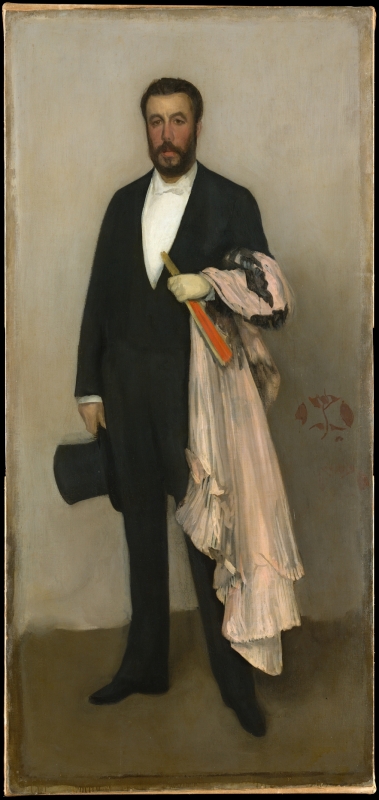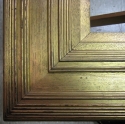Home > Catalogue > Browse > Arrangement en couleur chair et noir: Portrait de Théodore Duret << >>
Composition
There is some evidence of the numerous sittings required to complete this portrait, including several pentimenti. Many small alterations were made to the figure: his top hat was originally 2.5 cm (1") higher, his left foot 1.3 cm (½") to the right, his right leg 4 cm (1 ½") further left and that foot 5 cm (2") higher.
Technique
The canvas is of fine weave, and the background was painted softly, with few brushmarks visible. The figure was built up with several thin layers of paint. The head is warm in colour, solidly modelled, the planes blocked in with a small brush – 3 mm (1/8") wide. The outline of the figure is unusually clear cut. The domino is painted freely with long brush strokes – the pink is shot with orange and lilac – and the paint is so thin that the pattern of grey and black painted over the pink has dripped down over Duret's elbow.
The canvas was completely repainted at least ten times over the sittings, which took place at intervals over at least two years. Duret described Whistler as working without any preliminary sketch:
'[il] se mit à attaquer le portrait sans dessin préliminaire. Il avait tout juste posé à la craie, sur la toile blanche, quelques repères pour indiquer en haut la tête, en bas les pieds, à droite et à gauche, la place du corps. Il appliqua tout de suite sur la toile les couleurs et les tons, tels qu'ils devraient exister dans le tableau définitif. A la fin de la séance, on pouvait déjà juger de la physionomie générale qu'aurait l'oeuvre.' 1
Translation: '[H]e began to attack the portrait without any preliminary drawing. He merely put on the white canvas a few chalk marks to indicate the top of the head and the end of the feet, on right and left, the sides of the body. He placed immediately on the canvas the colours and tones, just as they ought to be in the finished picture. At the end of the sitting one could already judge the general appearance that the work would have.' 2
Duret's account, as published in translation in 1917 continues as follows:
'He posed me standing in front of a rose-grey hanging, the domino thrown over my left arm, bareheaded, the hat held in the hand of the right arm, which hung down ... It had, as first motive, a man standing, seen full face, in evening dress, and then the domino permitted him to realise that combination of colour of a decorative order that he introduced into every work he painted. The black of the suit, the pink of the domino and the grey of the background formed an Arrangement in Flesh-colour and Black. Finally, the domino, falling over the left leg and covering part of it, had allowed him to destroy the ugly parallelism of the two sides of the body and to diversify the contours. This idea of the domino, then, had come to him as a true painter's invention: from a very simple object he had gathered the unexpected arrangement of a picture.
He made me pose for long sittings. He was painting at the same time as my portrait that of Lady Archibald Campbell. He put the two works abreast and I was able to observe the parallel stages through which he made them pass. One of his principal anxieties was to maintain the appearance of things produced without effort. Instead of adding details, he rather suppressed them, and guarded above everything from making them abundant. ...
Another point in the execution of a painting to which he paid the greatest attention was to maintain the relation of tones between all the parts. For example, in a subject like my portrait, where the arrangement in flesh-colour and black was formed by the black suit on one hand and by the pink domino and grey background on the other, as soon as the slightest deviation of tone appeared, whether in the black of the suit or the grey of the background, he put a new layer of colour over the whole picture, so as to bring the least parts of it into the exact relationship which constituted the desired arrangement. Thus he had to repaint perhaps ten times the figure and the background. Reworked upon, after three attacks, this portrait was not finished till several months after it had been commenced. Today the practised eye easily recognises by its construction that it can only have been brought about by prolonged application, but when it was first shown in the Paris Salon of 1885 it was found, according to the preconception then existing, to have the character of a sketch, and most people thought that its execution had only required a very short time. He had therefore well fulfilled the first rule of his aesthetics, that a painting much worked upon should nevertheless appear as if come at one stroke and without effort.' 3
According to Elizabeth and Joseph Pennell,
'M. Duret, when he shows you the picture, in his apartment at Paris, will take a sheet of paper, cut a hole in it, and place it against the background, to prove that the grey, when surrounded by white, is pure and cold, without a touch of rose, and that Whistler got his effect by his knowledge of the relation of colours, and his mastery of the tones he wished to obtain.' 4
Conservation History
Roger Elliot Fry (1866-1934), writing in February 1909 after having seen Arrangement en couleur chair et noir: Portrait de Théodore Duret in Paris, and almost certainly discussed it with Duret, said that Whistler 'took three months to paint it, allowing each couche to dry thoroughly. Consequently there is no cracking or dragging at all'. 5
Frame
1884: Portrait Whistler [17.2 cm]. 6
The painting was probably framed about 1884 before it was bought by the sitter.
Notes:
3: Duret 1917 [more], pp. 69-72. The original French text, not reproduced here, is in Duret 1904 [more], pp. 101-05.
4: Pennell 1908 [more], vol. 1, pp. 306-08.
5: Sutton, Denys, (ed.)., The Letters of Roger Fry, 2 vols., London, 1972, pp. 310-13.
6: Dr S. L. Parkerson Day, Report on frames, 2017; see also Parkerson 2007 [more].
Last updated: 4th December 2020 by Margaret








